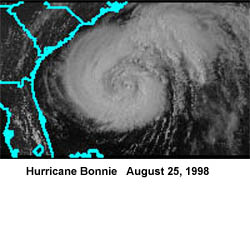
And Dorothy says.....
|
Tornadoes come from the energy released in a thunderstorm. As powerful as they
are, tornadoes account for only a tiny fraction of the energy in a thunderstorm. What
makes them dangerous is that their energy is concentrated in a small area, perhaps only a
hundred yards across. Not all tornadoes are the same, of course, and science does not yet
completely understand how part of a thunderstorm's energy sometimes gets focused into
something as small as a tornado. Whenever and wherever conditions are right,
tornadoes are possible, but they are most common in the central plains of North America,
east of the Rocky Mountains and west of the Appalachian Mountains. They occur mostly
during the spring and summer; the tornado season comes early in the south and later in the
north because spring comes later in the year as one moves northward. They usually occur
during the late afternoon and early evening. However, they have been known to occur in
every state in the United States, on any day of the year, and at any hour. They also occur
in many other parts of the world, including Australia, Europe, Africa, Asia, and South
America.
A look at the Ft. Worth/Arlington tornado
from 3/27/2000.
|



